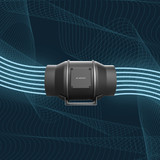What Does Passive Intake Do in Grow Tents?

If you are growing plants inside, you’re likely doing so with a grow tent to control the environment. Consequently, you’ll need to provide a constant supply of CO2 for your plants to grow. This means creating air circulation to bring in that fresh air. Ventilation is a two-part process: intake and exhaust. While air is blown out of grow tents, fresh air comes in to maintain good air quality. This process flushes out pollutants, promoting good health and comfort.
Today we’re going into the passive intake end of ventilation, how it works to bring in fresh air and when it is effective. It may seem strange that air can flow in through a vent opening, but there are forces at work that are simple to understand.
Why Do I Need Air Circulation?
While growing inside has its benefits, it comes with its own set of issues as well. Since there’s no access to regular wind, your plants are subject to stagnant air, mold, and pests. A steady flow of fresh air and a slight breeze can prevent these things from adversely affecting your plant growth while strengthening stems and controlling temperature and humidity.
How Does Passive Intake Work?
Your indoor space has negative static pressure that resists air movement from a fan, which creates positive static pressure. The differences in pressure between the inside and the outside of your grow tent creates the pulling force that brings passive air in. Think of this airflow like drinking from a straw. The bottom end is a passive intake; nothing is blowing liquid into the straw. Your mouth (exhaust fan) pulls your drink through the straw and into your mouth which essentially does all the work.
With no intake fan actively bringing in outside air, your exhaust fan does most of the work. To ensure it blowing at an effective rate, the intake opening must be three to four times larger than the exhaust opening. Alternatively, you may create multiple opening to make up the 3-4 times size opening. Filters may be applied to the opening(s) to keep dust and insects out. The size of intake holes doesn’t matter as much in active intake systems.
When is it Best Effective?
Passive intake air is most effective when using lighting systems under 400 watts. Depending on what kind of lighting you’re using (LED, high-pressure sodium, etc.) your grow lights emit a certain amount of heat. At 400 watts your lamp’s heat output can be exhausted by a low CFM inline fan while being replaced by passive air. This method is recommended for smaller grow tents. Larger grow tents can benefit from using passive air intake as well but will require higher CFM exhaust fans.
Air intake is only a part of the indoor growing equation. Many factors like grow tent size, grow lights, and inline fans contribute to creating the optimal growing environment. Look out for our ventilation web guide coming soon!



